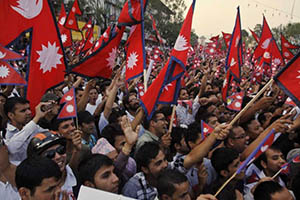PEOPLE IN NEPAL
Like the geography, the population of Nepal extremely diverse and highly complex. Simplistically, Nepal is the meeting point for the Indo-Aryan people of Indian with the Tibeto-Burman of the Himalaya, but this gives little hint of the dynamic ethnic mosaic that has developed and continues to change to this day. In a south-north direction, as you move from the plains to the mountains, the ethnic map can be roughly divided into layers: the Terai, the midlands or Pahad zone, and the Himalaya. Each zone is dominated by characteristic ethnic groups whose agriculture and lifestyles are adapted to suit the physical constraints of their environment. In the Himalayan zone, the people are Monologian of Tibetan descent. They are known as bhote in Nepali. In the east of the midlands zone, one find Kirati people had known as Rai, Limbu groups. They speak Tibeto-Burman Language. In the Terai zone, after the eradication of malaria in the 1950s the only people to live in the valley were Tharus of Hindu overtones.
 Anthropologists divide the people of Nepal into about 50 ethnic groups or castes with their own culture and traditions. Everyone is proud of their heritage. Many people use the name of their ethnic group, caste or clan as their surname. The caste system has many occupational castes such as Brahmins (Hindu Priests), Chhetris (farmers in the hills and soldiers), Newars (the original inhabitants of Kathmandu Valley), Thakalis, Gurungs, Rais, Limbus, Tamangs, Magars, Potters, butchers, blacksmiths, cobblers, goldsmiths, clothes washers, etc.
Anthropologists divide the people of Nepal into about 50 ethnic groups or castes with their own culture and traditions. Everyone is proud of their heritage. Many people use the name of their ethnic group, caste or clan as their surname. The caste system has many occupational castes such as Brahmins (Hindu Priests), Chhetris (farmers in the hills and soldiers), Newars (the original inhabitants of Kathmandu Valley), Thakalis, Gurungs, Rais, Limbus, Tamangs, Magars, Potters, butchers, blacksmiths, cobblers, goldsmiths, clothes washers, etc.
People: Nepal has a composite population stemming from various racial and ethnic communities. It has been a melting pot of diverse linguistic and ethnic groups with population of 25.4 million living in different regions, wearing different costumes and speaking different language and dialects. The people belong to multi-ethnic groups, ranging from the Indo-Aryan to Mongoloid. The Himalayan and central hill regions are mostly inhabited by the people of the Tibeto-Burman strand while the people inhabiting the Terai lowlands may be grouped under the Indo-Aryan category. Its cultural traditions, art and literary heritage go back to thousands of years. The varied mosaic of various races and ethnic groups have given to Nepal a distinct character and culture. The Nepali language is said to have derived from Indo-European language but through long association with its neighbors, it has adopted many Tibeto-Burman words.